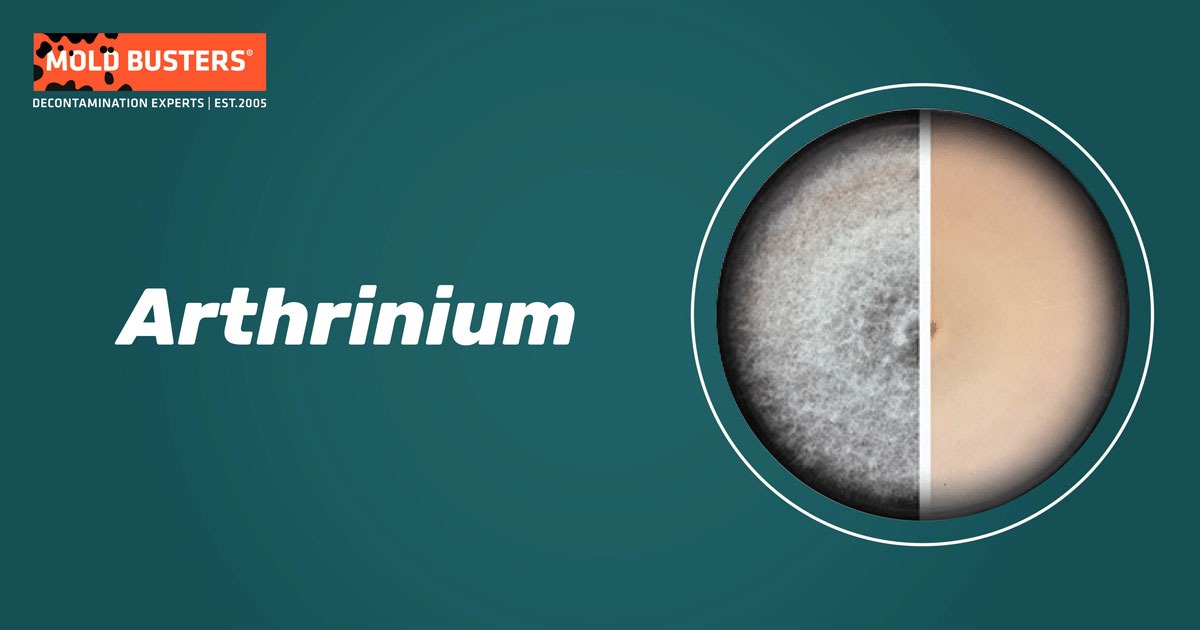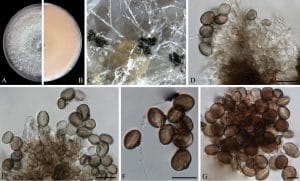What is Arthrinium?
Arthrinium is a fungal genus that belongs to the family Apiosporaceae, order Xylariales, and class Sordariomycetes within the Ascomycota phylum. The genus was introduced in 1817 by Schmidt and Kunze and confirmed by Fries in 1832 [1,2]. Today, this genus contains 91 species [3], with A. caricicola as the type species, isolated from the Carex plant (Cyperaceae) [1,2]. It is a widespread and diverse genus: some species are plant saprobes; endophytes of plant tissue, lichens, and marine algae; plant pathogens on barley and wheat; and human pathogens causing cutaneous infections [4]. They can also be found indoors, on water-damaged, composite wood and plywood, plaster, wallpaper, and painted surfaces [5,6]. One of the most important species are A. phaeospermum and A. sacchari, as they produce compound 3-nitropropionic acid (3-NPA), a highly toxic and potentially fatal compound [7].

What is the phylogeny of Arthrinium?
The genus Arthrinium was described in 1817 [4] and in earlier literature was known by its synonym Papularia [8]. Until recently, Arthrinium classification was based on morphological characteristics such as conidial and conidiophores shape, the presence or absence of sterile cells, and septae [1]. Since Arthrinium species are morphologically variable, a comprehensive molecular analysis was conducted in 2013 to circumcise the Arthrinium genus.
Crous and Groenewald [4] suggested that the related genera Pteroconium and Cordella should be treated as synonyms for the Arthrinium genus and that conidia shape and the presence of septae are not reliable markers for distinguishing all species in this complex. Also, the sexual genus Apiospora should be treated as an Arthinium synonym since Arthinium is an older and more frequently found genus [4].
What does Arthrinium look like?
Arthrinium species produce large, dark conidia formed on short and narrow conidiophores (Fig. 1) [8]. This genus is different from other anamorphic genera because it forms basauxic conidiophores, which arise from structures called conidiophore mother cells [9]. The basauxic conidiophores emerge from conidiophore mother cells, which are formed from the vegetative mycelium.
Arthrinium species can be divided into two groups based on conidial shape. The first group has an irregular or a conidial polygon shape, while the second group produces globose or ellipsoid conidia [1]. The sexual state of Arthrinium belongs to the genus Apiospora, which forms perithecial stromata with hyaline apiospores [10].

Arthrinium species can morphologically differ when growing on different substrates or during different incubation periods. Furthermore, morphological characteristics of the same species can differ when observed in vitro or in vivo [4]. Characteristics of the most common Arthrinium phaeospermum are the following: fast-growing, white to the grey colony, elliptical, dark brown, smooth-walled conidia, 8–12 x 5–7 µm size, with a narrow, hyaline band around the longest part.
Arthrinium conidia are highly resistant to heat since they can survive apple juice pasteurizing process of 88°C (190°F) for 1.5 min and being heated in water at 105°C (221°F) for 2.5 min [8].
How many species of Arthrinium are there?
Arthrinium is the largest genus within the Apiosporaceae family, containing 91 species [3]. These species are detected from a variety of hosts. They can be saprobes, endophytes, pathogenic fungi of plants and humans. For instance, A. arundinis causes kernel blight of barley, A. sacchari causes damping-off of wheat.
A. phaeospermum can cause the culm rot on Phyllostachys viridis and cutaneous infections of humans [4,11], while A. aurundinis causes onychomycosis [12]. Furthermore, novel Arthrinium species are constantly being discovered. In 2021, eight new species were discovered in marine habitats in Korea [1], and four new species were reported from bamboo trees in China [11].
Where can Arthrinium be found?
A. phaeospermum was found to grow indoors on composite wood and plywood [5,6]. This species can also grow on water-damaged wood, plaster, wallpapers, and painted surfaces. In these environments, they often compete with molds such as Aureobasidium pullulans, Cladosporium herbarum, Trichoderma spp., Rhodotorula mucilaginosa, and other species [6]. Arthrinium spp. were noted as dominant molds in some healthcare facilities [13], while in Japan, they were detected in higher incidence on bathrooms surfaces [14].
Is Arthrinium toxic?
Some Arthrinium species produce 3-nitropropionic acid (3-NPA), a lipophilic and highly toxic compound detected in moldy sugar cane parts and coconut spoiled water [7,15]. The most common causal agents of moldy sugarcane are A. phaeospermum and A. sacchari, followed by A. terminalis, A. saccharicola, A. aureum, and A. sereanis [7]. At the same time, the coconut water spoilage was caused by A. saccharicola [15].
Sugar cane poisonings in humans are reported in China and Africa, while coconut poisonings occurred in Denmark. Symptoms of poisoning were: vomiting, nausea, diarrhea, and progressing encephalopathy leading to coma and death. Ten percent of the sugarcane poisonings ended with fatalities, while some resulted in lifelong disabilities. The only reported coconut poisoned case ended with mortality [7,15].
The toxic dose for humans is unknown, but toxicological research on mice showed the oral lethal dose to be 68 mcg/g. Due to the lack of symptoms expression in this experiment, authors assumed rodents are more resistant to toxicity than humans [15]. The highest detected level of NPA was 1.7 mg/ml, produced by A. sacchari when cultured at 24°C (75°F) for 2 weeks. The optimum temperature for NPA toxin production is 24°C (75°F), while the optimum pH is around 5.0 [7].
What are the effects of Arthrinium?
Arthrinium species produce a vast array of secondary metabolites, including different classes such as xanthones, peptides, diterpenes, sesquiterpenes [16], and quinines [17]. Originally isolated naphthoquinone was bostrycin from A. phaeospermum in 1975. This compound was used as a red pigment in the textile industry. Apart from bostrycin, Arthrinium species produce arthrinone, cerdarin, flaviolin, gentisyl alcohol, and 1,3,6,8-tetrahydroxynaphthalene [17].
Many Arthrinium isolates produce extrolites (secondary metabolites secreted to the extracellular medium) that exhibit significant toxicity against human cancer cell lines, yeasts, bacteria, and fungi [1,4]. Particularly interesting are the Arthrinium species that originate from a marine environment since they possess promising bioactive properties, such as high enzymatic activity, antifungal activity, and antioxidant capacity [1]. In addition, Pansanit and Pripdeevech [18] demonstrated that ethyl acetate extract of Arthrinium sp. significantly inhibited the growth of gram-positive bacteria S. aureus, S. epidermidis and S. agalactiae. A. arundinis has been used in the pharmaceutical industry as an antifungal agent [10].

Did you know?
Only 11% of tested bedrooms in Canada didn’t have any mold type present?! Find out more exciting mold stats and facts on our mold statistics page.
References
- Kwon SL, Park MS, Jang S, Lee YM, Heo YM, Hong J-H, Lee H, Jang Y, Park J-H, Kim C, Kim G-H, Lim YW, Kim J-J (2021). The genus Arthrinium (Ascomycota, Sordariomycetes, Apiosporaceae) from marine habitats from Korea, with eight new species. IMA Fungus, 12:13.
- Pintos A, Alvarado P. (2021). Phylogenetic delimitation of Apiospora and Arthrinium. Fungal Systematics and Evolution, 7:197–221.
- Retrieved from (november, 2021): http://www.indexfungorum.org.
- Crous PW, Groenewald JZ (2013). A phylogenetic re-evaluation of Arthrinium. IMA Fungus, 4:133–154.
- Flannigan B, Miller JD (2011). Microbial growth in indoor environments. Diversity, Health Impacts, Investigation and Control. In Microorganisms in Home and Indoor Work Environments (Flannigan et al. eds.). CRC Press, Taylor and Francis Group, pp. 80.
- Andersen B, Frisvad JC, Søndergaard I, Rasmussen IS, Larsen LS (2011). Associations between Fungal Species and Water-Damaged Building Materials. Applied and Environmental Microbiology, 77(12):4180–4188.
- Wei D-L, Chang S-C, Lin S-C, Doong M-L, Jong S-C (1994). Production of 3-nitropropionic acid by Arthrinium Current Microbiology volume 28:1–5.
- Pitt JI, Hocking AD (2009). Fungi and food spoilage. New York, NY: Springer, pp. 72,73.
- Pintos A, Alvarado P, Planas J, Jarling R (2019). Six new species of Arthrinium from Europe and notes about caricicola and other species found in Carex spp. hosts. MycoKeys, 49: 15-48.
- Dai DQ, Jiang HB, Tang LZ, Bhat DJ (2016). Two new species of Arthrinium (Apiosporaceae, Xylariales) associated with bamboo from Yunnan, China. Mycosphere 7(9):1332–1345.
- Feng Y, Liu J-K, Lin C-G, Chen Y-Y, Xiang M-M, Liu Z-Y (2021). Additions to the Genus Arthrinium (Apiosporaceae) From Bamboos in China. Frontiers in Microbiology, 12:Article 661281.
- Vettorato R, Heidrich D, Eidt LM, Machado Pagani D, Carvalho Ribeiro A, Dallé da Rosa P, Vettorato G, Guarienti Amaro T, Scroferneker ML (2020). Onychomycosis caused by Arthrinium arundinis in leprosy patient: Case report. Medical Mycology Case Reports, 30:19-21.
- Seo SC (2020). Health Effects of Exposure to Indoor Mold and the Levels of Mold in Facilities with Susceptible Populations in Korea. Journal of Environmental and Health Science, 46(4):359-367.
- Moriyama Y, Nawata N, Tsuda T, Nitta M (1992). Occurrence of Moulds in Japanese Bathrooms. International Biodeterioration and Biodegradation 30:47-55.
- Birkelund T, Johansen RF, Illum DG, Dyrskog SE, Østergaard JA, Falconer TM, Andersen C, Fridholm H, Overballe-Petersen S, Jensen JS (2021). Fatal 3-Nitropropionic Acid Poisoning after Consuming Coconut Water. Emerging Infectious Diseases, 27(1):278–280.
- Elissawy AM, Ebada SS, Ashour ML, Özkaya FC, Ebrahim W, Singab AB, Proksch P (2017). Spiroarthrinols a and B, two novel meroterpenoids isolated from the sponge-derived fungus Arthrinium Phytochemistry Letters, 20:246–251.
- Christiansen JV, Isbrandt T, Petersen C, Sondergaard TE, Nielsen MR, Pedersen TB, Sørensen JL, Larsen TO, Frisvad JC (2021). Fungal quinones: diversity, producers, and applications of quinines from Aspergillus, Penicillium, Talaromyces, Fusarium, and Arthrinium. Applied Microbiology and Biotechnology, 105:8157–8193.
- Pansanit A, Pripdeevech P (2018). Antibacterial secondary metabolites from an endophytic fungus, Arthrinium sp. MFLUCC16-1053 isolated from Zingiber cassumunar. Mycology, 9(4):264-272.

Get Special Gift: Industry-Standard Mold Removal Guidelines
Download the industry-standard guidelines that Mold Busters use in their own mold removal services, including news, tips and special offers:

Written by:
Aleksandra Zebeljan
Mycologist
Mold Busters
Edited by:
Dusan Sadikovic
Mycologist – MSc, PhD
Mold Busters
